Active Voice and Passive Voice Exercises for Class 10
Understanding the difference between active and passive voice is crucial for effective communication in English. Active voice is generally preferred for its clarity and directness, while the passive voice can be useful in certain situations. Here are some exercises to help Class 10 students practice identifying and converting between active and passive voice:
Exercise 1: Identifying Active and Passive Voice
Instructions: Read each sentence and identify whether it is in the active voice or the passive voice. Write 'AV' for active voice and 'PV' for passive voice.
- The dog chased the ball.
- The ball was chased by the dog.
- The cake was baked by my mother.
- My mother baked the cake.
- The window was broken by the wind.
- The wind broke the window.
- The book was read by the student.
- The student read the book.
Answers:
- AV
- PV
- PV
- AV
- PV
- AV
- PV
- AV
Exercise 2: Converting from Active to Passive Voice
Instructions: Rewrite each sentence in the passive voice. Remember to include the agent (the person or thing doing the action) if it is relevant.
- The teacher corrected the students' homework.
- The carpenter built the table.
- The artist painted the portrait.
- The chef prepared the delicious meal.
- The gardener watered the plants.
Answers:
- The students' homework was corrected by the teacher.
- The table was built by the carpenter.
- The portrait was painted by the artist.
- The delicious meal was prepared by the chef.
- The plants were watered by the gardener.
Exercise 3: Converting from Passive to Active Voice
Instructions: Rewrite each sentence in the active voice. Identify the agent in each sentence.
- The letter was written by my friend.
- The game was won by the home team.
- The song was sung by the choir.
- The house was painted by the workers.
- The story was read by the children.
Answers:
- My friend wrote the letter. (Agent: my friend)
- The home team won the game. (Agent: the home team)
- The choir sang the song. (Agent: the choir)
- The workers painted the house. (Agent: the workers)
- The children read the story. (Agent: the children)
Exercise 4: Using Active and Passive Voice Strategically
Instructions: Read the following situations and decide whether the active or passive voice would be more appropriate. Explain your reasoning.
- Situation: You are writing a report about a scientific experiment.
- Situation: You are writing a news article about a robbery.
- Situation: You are writing a letter to a friend about your weekend.
Answers:
- Passive voice: The passive voice is often used in scientific writing to emphasize the process or result rather than the person who conducted the experiment. For example, "The experiment was conducted in a controlled environment."
- Active voice: The active voice is generally more suitable for news reports as it provides a direct and engaging style. For example, "The robbers stole money from the bank."
- Active voice: The active voice is more personal and conversational, making it appropriate for informal writing like a letter to a friend. For example, "I went to the beach with my family on Saturday."
These exercises are just a starting point for practicing active and passive voice. Encourage students to explore different scenarios and situations to further develop their understanding of these grammatical concepts.
